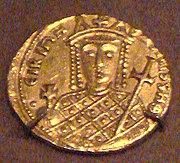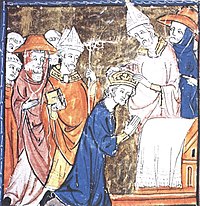| No Title | |
|---|---|
|
No Title |
No information |
Irene Sarantapechaina (Greek: Ειρήνη Σαρανταπήχαινα), known as Irene of Athens or Irene the Athenian (Greek: Ειρήνη η Αθηναία) (c. 752 – August 9, 803) was a Byzantine empress regnant from 797 to 802, having previously been Empress consort from 775-780, and empress mother and regent from 780-797. As monarch she called herself basileus (βασιλεύς), 'emperor', rather than basilissa (βασίλισσα), 'empress'.
Early life and rise to power[]
Irene was born to a noble Greek family of Athens, the Sarantapechos family. Although she was an orphan, her uncle, Constantine Sarantapechos, was a patrician and possibly strategos of the theme of Hellas. She was brought to Constantinople by Emperor Constantine V on November 1, 769, and was married to his son Leo IV on December 17. Although she appears to have come from a noble family, there is no clear reason as to why she would have been chosen as Leo's bride, leading some scholars to speculate that she was selected in a bride-show, in which eligible women were paraded before the bridegroom, until one was finally selected.

This solidus struck under Irene reports the legend BASILISSH, Basilisse.
On January 14, 771, Irene gave birth to a son, the future Constantine VI. When Constantine V died in September 775, Leo was to succeed to the throne at the age of twenty-five years. Leo, though an iconoclast (opposed theologically to the veneration of icons), pursued a policy of moderation towards iconodules (those who venerated icons), but his policies became much harsher in August 780, when a number of courtiers were punished for icon-veneration. According to tradition, he discovered icons concealed among Irene's possessions and refused to share the marriage bed with her ever after. Nevertheless, when Leo died on September 8, 780, Irene became regent for their nine-year old Constantine.
Irene was almost immediately confronted with a conspiracy which she heard was to raise to the throne the Caesar Nikephoros, a half-brother of Leo IV. To overcome this challenge, she had Nikephoros and his co-conspirators ordained as priests, a status which disqualified them from ruling, and ordered them to administer Holy Communion on Christmas Day.
As early as 781, Irene began to seek a closer relationship with the Carolingian dynasty and the Papacy. She negotiated a marriage between her son and Rotrude, a daughter of Charlemagne by his third wife Hildegard. Irene went as far as to send an official to instruct the Frankish princess in Greek; however, Irene herself broke off the engagement in 787, against her son's wishes.
Irene next had to subdue a rebellion led by Elpidios, the strategos of Sicily, whose family was tortured and imprisoned, while a fleet was sent, which succeeded in defeating the Sicilians. Elpidius fled to Africa, where he defected to the Arabs. After the success of Constantine V's general, Michael Lachanodrakon, who foiled an Arab attack on the eastern frontiers, the strategos of the Bucellarii, Tatzates, defected to the Arabs, but due to the failure of negotiations Irene had to agree to pay a huge annual tribute of 70 or 90,000 dinars to the Arabs for a three-year truce, give them 10,000 silk garments and provide them with guides, provisions and access to markets during their withdrawal.
Rule and resolution of Iconoclasm controversy[]

Gold solidus of Irene, 797-802, Constantinople.
Her most notable act was the restoration of the Orthodox veneration of icons (images of Christ or the saints). Having elected Tarasios, one of her partisans, to the patriarchate in 784, she summoned two church councils. The first of these, held in 786 at Constantinople, was frustrated by the opposition of the soldiers. The second, convened at Nicaea in 787, formally revived the veneration of icons and reunited the Eastern church with that of Rome.[1] (See Seventh Ecumenical Council.)
While this improved relations with the Papacy, it did not prevent the outbreak of a war with the Franks, who took over Istria and Benevento in 788. In spite of these reverses, Irene's military efforts met with some success: in 782 her courtier Staurakios subdued the Slavs of Greece and laid the foundations of Byzantine expansion and re-Hellenization in the Balkans. Nevertheless, Irene was constantly harried by the Abbasids, and in 782 and 798 had to accept the terms of the respective Caliphs Al-Mahdi and Harun al-Rashid.
As Constantine approached maturity he began to grow restless under her autocratic sway. An attempt to free himself by force was met and crushed by the empress, who demanded that the oath of fidelity should thenceforward be taken in her name alone. The discontent which this occasioned swelled in 790 into open resistance, and the soldiers, headed by the Armenian guard, formally proclaimed Constantine VI as the sole ruler.
A hollow semblance of friendship was maintained between Constantine and Irene, whose title of empress was confirmed in 792; but the rival factions remained, and Irene, by skillful intrigues with the bishops and courtiers, organized a powerful conspiracy on her own behalf. Constantine could only flee for aid to the provinces, but even there he was surrounded by participants in the plot. Seized by his attendants on the Asiatic shore of the Bosphorus, Constantine was carried back to the palace at Constantinople; and there, by Irene's orders, his eyes were gouged out. He died from his wounds several days later. A solar eclipse and a darkness of 17 days' duration were attributed by common superstition to the horror of Heaven.
Legacy[]

Refusing to recognize Irene's reign, Pope Leo III crowned Charlemagne as Holy Roman Emperor.
Irene reigned for five years, from 797 to 802. Pope Leo III, who needed help against enemies in Rome and who saw the throne of the Byzantine emperor as vacant (lacking a male occupant), crowned Charlemagne as Roman Emperor in 800. This was seen as an insult to Byzantium and the Orthodox Church and caused another rift between the Eastern Orthodox Church and the Roman Catholic Church. Nevertheless, Irene is said to have endeavoured to negotiate a marriage between herself and Charlemagne; but according to Theophanes the Confessor, who alone mentions it, the scheme was frustrated by Aetios, one of her favourites.[2]
In 802 the patricians conspired against her and placed on the throne Nikephoros, the minister of finance (logothetēs tou genikou). Irene was exiled to Lesbos and forced to support herself by spinning. She died the following year.
Her zeal in restoring the icons and monasteries made Theodore the Studite praise her as a saint[3] of the Eastern Orthodox Church, but she was not canonized. However, there are claims about her supposed canonization, mainly from Western sources.[4] Such claims are not supported by the Menaion (the official liturgical book providing the propers of the saints of the Orthodox Church), the "Lives of Saints" by Nikodemos the Hagiorite, or any other relative book of the Orthodox Church.
Family[]
By her marriage to Emperor Leo IV the Khazar, Irene had only one son Constantine VI, whom she succeeded on the throne. A female relative of Irene, Theophano was chosen in 807 by Emperor Nikephoros I as the bride of his son and heir Staurakios. An unnamed female relative was married to the Bulgar ruler Telerig in 776. Irene also had a nephew.[5]
References[]
- ↑ See Alexander, et al., p. 423.
- ↑ See Garland, p. 89, who explains that Aetios was attempting to usurp power on behalf of his brother Leo.
- ↑ Theodori Studitae Epistulae, Volume 2 (Berlin, 1992).
- ↑ Vita Irenes, 'La vie de l'impératrice Sainte Irène', ed. F. Halkin, Analecta Bollandiana, 106 (1988) 5-27; see also W.T. Treadgold, 'The Unpublished Saint's Life of the Empress Irene', Byzantinische Forschungen, 7 (1982) 237-51.
- ↑ Herrin, p. 56, 70, 134.
External links[]
| Wikimedia Commons has media related to: Irene |
Primary Sources
- Anastasius Bibliothecarius Chronographia tripartita
- Theophanes Chronographia
Secondary Sources
- The Oxford Dictionary of Byzantium, Oxford University Press, 1991.
- Alexander, Archibald, and André Lagarde, Joseph Turmel. The Latin Church in the Middle Ages, C. Scribner's Sons, 1915.
- Barbe, Dominique. Irène de Byzance: La femme empereur, Paris, 1990.
- This article incorporates text from the Encyclopædia Britannica, Eleventh Edition, a publication now in the public domain.
- Herrin, Judith (2001). Women in Purple:Rulers of Medieval Byzantium. London: Phoenix Press. ISBN 1-84212-529-X.
- Garland, Lynda (1999). Byzantine Empresses: Women and Power in Byzantium, AD 527-1204. London: Routledge. ISBN 0415146887.
- Wace, Henry and William Smith, A Dictionary of Christian Biography, Literature, Sects and Doctrines, J. Murray, 1882.
Irene of Athens Isaurian Dynasty Born: c. 752 Died: 9 August 803
| ||
| Regnal titles | ||
|---|---|---|
| Preceded by Constantine VI |
Byzantine Empress 797–802 |
Succeeded by Nikephoros I |
| Royal titles | ||
| Preceded by Eudokia |
Byzantine Empress consort 775-780 |
Succeeded by Maria of Amnia |
| Preceded by Anna |
Empress-Mother of the Byzantine Empire 780–797 |
Succeeded by Prokopia |
| |||||||||||||||||||||||
an:Irene (emperadora) bg:Ирина Атинянката ca:Irene de Bizanci cs:Irena (Byzanc) cy:Irene (ymerodres) gl:Irene ko:이레네 la:Irene Atheniensis lt:Imperatorė Irena hu:Eiréné bizánci császárnő ja:エイレーネー pt:Irene de Atenas ro:Irina Ateniana ru:Ирина (византийская императрица) sk:Irena (cisárovná) sr:Ирина (царица) fi:Irene sv:Irene (bysantinsk kejsarinna) tr:İrene (imparatoriçe) zh:伊琳娜女皇